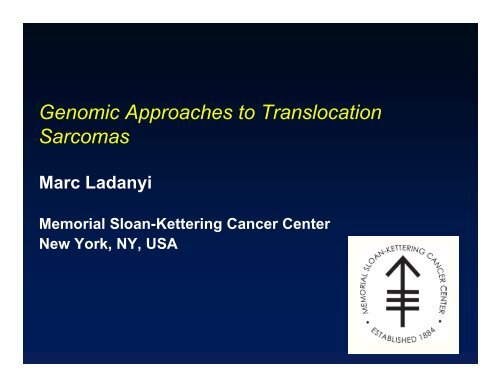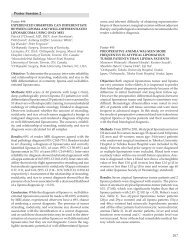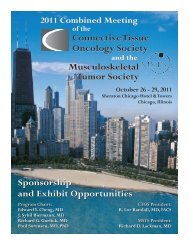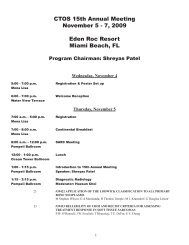Nina Axelrad Lecture
Nina Axelrad Lecture
Nina Axelrad Lecture
- No tags were found...
You also want an ePaper? Increase the reach of your titles
YUMPU automatically turns print PDFs into web optimized ePapers that Google loves.
Molecular pathology of sarcomas: two major classesKaryotypesTranslocationsTelomere maintenancemechanismsP53 pathway alterationsIncidence in P53-mutantor knockout miceIncidence in bilateralretinoblastoma andLi-Fraumeni syndromeMouse modelsGlobal gene expressionprofilesSarcomas with specifictranslocationsUsually simpleReciprocal & specific,producing fusion genesTelomerase common,ALT mechanism rareRelatively rare, but strongprognostic impactNot observedRareVery difficultRobust clusteringSarcomas withoutspecific translocationsUsually complexNon-reciprocal & nonspecific,causing gene copynumber changesALT mechanism morecommon than telomeraseMore frequent, but limitedor no prognostic impactCommonCommonLess difficultLooser clustering
Sarcoma Genome ProjectSamuel SingerChris SanderMarc LadanyiCristina AntonescuRobert MakiMSKCC BROAD Matt MeyersonMSKCC &MIT-BROADJordi BarretinaHeidi GreulichStacey GabrielWendy WincklerSamplesRNA and DNA extractionGene selection250K Affy SNP arrays forcopy number and LOHanalysisU133A Affy expression arraysMicroRNA profilingComputational analysisSequencing of 225 genesand 450 microRNA genesSequenom validation ofcandidate mutationsTargeted functional validation
Samples run on Affy 250K SNP arrays(as of October 2007)SubtypeKaryotypeTotalDedifferentiated liposarcomaMyxoid/round cell liposarcomacomplex, 12q rings + giantmarkerssimple, t(12;16)5021Pleomorphic liposarcomaMFHGastrointestinal stromal tumorSynovial sarcomaLeiomyosarcomaTOTALcomplexcomplexsimple, monosomy 14simple, t(X;18)complex2438222527207… + matched normals (205)Paired Affy U133A expression data for 141 samples
Genomic Approachesto Translocation SarcomasAgenda‣ Expression profiling: mining for diagnostic andtherapeutic targets• ChIP-on-chip: integration with expression profilingdata to identify target genes of chimerictranscription factors in translocation sarcomas• Cancer genomics: new approaches to highthroughput unbiased discovery of translocations
Most fusion genes resulting from sarcomatranslocations encode aberrant transcription factorsSarcoma typeEwing sarcomaClear cell sarcomaMyxoid liposarcomaAlveolarrhabdomyosarcomaDSRCTExtraskeletal myxoidchondrosarcomaSynovial sarcomaEndometrial stromalsarcomaAlveolar soft part sarcomaLow grade fibromyxoidsarcomaPericytomaAngiomatoid fibroushistiocytomaTranslocationt(11;22)t(21;22)t(12;22)t(2;22)t(12;16)t(2;13)t(1;13)t(11;22)t(9;22)t(9;17)t(X;18)t(7;17)t(X;17)t(7;16)t(7;12)t(12;22)t(2;22)Fusion geneEWS-FLI1EWS-ERGEWS-ATF1EWS-CREB1FUS-CHOPPAX3-FKHRPAX7-FKHREWS-WT1EWS-NR4A3EWS-TAF2NSYT-SSX1,2JAZF1-JJAZ1ASPL-TFE3FUS-BBF2H7ACTB-GLIEWS-ATF1EWS-CREB1
Unsupervised clustering based on kinase genesTranslocation sarcomas express distinctive repertoires of kinasesES ARMS DSRCTSS ASPS→ 739 probe sets on U133A chip representing 432 kinase genes
Supervised comparisons based on kinase genesTranslocation sarcomas express distinctive repertoires of kinasesEwing Sarcoma/PNETDifferentially overexpressedkinasesKinaseGenePRKCB1DAPK1KITJAK1VRK1EPHA4Fold40.35.95.44.94.23.5T testp-value2.1E-195.5E-107.6E-101.0E-131.0E-173.0E-10AlveolarRhabdomyosarcomaDifferentially overexpressedkinasesKinaseGeneTTNFGFR4METERBB3DAPK1Fold55.98.06.04.22.6T testp-value5.0E-304.9E-123.4E-111.6E-091.0E-08Synovial SarcomaDifferentially overexpressedkinasesKinaseGenePDGFRAFGFR3NTRK2FGFR1Fold14.58.34.73.9T testp-value6.9E-363.0E-263.2E-087.5E-24Baird et al., 2005 (Meltzer group)
Differentially expressed kinases intranslocation sarcomas• Basis:– Lineage-associated (e.g. like KIT in GIST)– Oncogenic role (e.g. like KIT in GIST; like EGFR inEGFR-mutant lung adenoCA)– Transcriptional targets of chimeric transcription factor• Pathogenic activation:– Aberrant overexpression due to transcriptionalupregulation– Amplification (unlikely)– Mutation
Sequencing of kinases showing relative overexpression inspecific translocation sarcomasEwing Sarcoma/PNETDifferentially overexpressedkinasesKinaseGenePRKCB1DAPK1KITJAK1VRK1EPHA4Fold40.35.95.44.94.23.5T testp-value2.1E-195.5E-107.6E-101.0E-131.0E-173.0E-10AlveolarRhabdomyosarcomaDifferentially overexpressedkinasesKinaseGeneTTNFGFR4METERBB3DAPK1Fold55.98.06.04.22.6T testp-value5.0E-304.9E-123.4E-111.6E-091.0E-08Synovial SarcomaDifferentially overexpressedkinasesKinaseGenePDGFRAFGFR3NTRK2FGFR1Fold14.58.34.73.9T testp-value6.9E-363.0E-263.2E-087.5E-24• Mutation screens -> essentially negative– PRKCB1: 0/28 ES/PNET– JAK1: 0/31 ES/PNET– EPHA4: 1/68 ES/PNET– PDGFRA: 0/27 SS (1 reported)– FGFR3: 0/30 SS– Etc…Neal Shukla, M.D.
Differentially expressed kinases intranslocation sarcomas• Basis:– Lineage-associated (e.g. like KIT in GIST)– Oncogenic role (e.g. like KIT in GIST; like EGFR inEGFR-mut lung CA)– Transcriptional targets of chimeric transcription factor• Pathogenic activation:– Aberrant overexpression due to transcriptionalupregulation– Amplification (unlikely)– Mutation
MET is a highly differentially overexpressed kinase in ASPSKinase Fold T-test p-valuePIM1 3.1 6.42E-10MAPK3 1.6 1.28E-09MET 4.9 2.91E-09H11 6.4 9.73E-09MAPKAPK2 1.6 1.68E-08PRKAG2 8.7 2.74E-08MKNK2 2.6 3.16E-08GPRK6 8.1 4.31E-08LYN 2.3 5.69E-08PACSIN2 2.1 1.02E-07FLT1 3.9 8.99E-07MAPKAP1 1.8 2.13E-06Masumi Tsuda, Ph.D.Comparison of 16 ASPS samples vs 123 samples of 4 other sarcomas
ASPL-TFE3 fusion gene in Alveolar Soft Part Sarcomader(17)t(X;17)(p11;q25)ASPL-TFE3 fusion arising fromt(X;17)(q25.3; p11.2)soft tissue– Rare soft tissue sarcoma– First described in 1952 (here)– F:M = 3:2, age range: 15-35– highly chemotherapy andradiation therapy resistant– site: within or next to skeletalmuscle– typical presentation: thigh massAlveolar Soft Part Sarcoma(ASPS)
ASPL-TFE3 fusion geneChimeric Transcription FactorASPL- 17q25- ubiquitously expressed cytoplasmicprotein involved in processing ofglucose transportersTFE3- Xp11.2- bHLH-LZ family transcription factorhighly related to MITF and TFEB- contains DNA binding domain and NLS- Consensus sequence CANNTGASPLTFE3ASPL-TFE3type1ASPL-TFE3type21 553ASPL-TFE3- replaces the N-terminal portion of TFE3 by the fused ASPL sequences- retains DNA binding domain and NLS, functions as transcription factor- Type 2 retains activating domain as well- more active than TFE3 in model assays11311UBX1 575AD bHLH-LZ261 29621NLS311 591bHLH-LZNLS311 626bHLHAD-LZNLS
ASPL-TFE3: a gene fusionfound in both a sarcoma and a carcinomaCellular backgroundKidneySoft tissueASPL-TFE3 Renal CarcinomaAlveolar Soft Part SarcomaOnly existing human cell line with endogenous ASPL-TFE3 translocation isfrom an ASPL-TFE3 renal carcinoma; there is no ASPS cell line available.
TFE3 gene fusions in human tumorsFusionTumorAgeTranslocationASPL-TFE3ASPS5-40der(17)t(X;17)(p11;q25)ASPL-TFE3Renal CA2-68t(X;17)(p11;q25)PRCC-TFE3Renal CA2-70t(X;1)(p11.2;q12)PSF-TFE3Renal CA5-68t(X;1)(p11.2;p34)NonO-TFE3Renal CA39inv(X)(p11.2;q12)CLTC-TFE3Renal CA14t(X;17)(p11;q23)Alpha-TFEBRenal CA10-42t(6;11)(p21;q13)“Translocation carcinomas of the kidney”
ASPL-TFE3 activates exogenous MET promoter constructMasumi Tsuda, Ph.D.1800016000P
ASPL-TFE3 is present at the MET promoter・Chromatin Immunoprecipitation assay (293 cells with inducible ASPL-TFE3)inputMOCKIgGanti-mycASPL-TFE3type1inputIgGanti-mycASPL-TFE3type2inputIgGanti-mycnega. con.posi. con.100 bp100 bpTet 0 hTet 46 h-2000 bp-1340bp-200bp-1310CANNTG(consensus bindingsequences for nativeTFE3 and ASPL-TFE3)↓TranscriptionStartSite
ASPL-TFE3 activates endogenous MET promoterNormalizedMET expression43.532.521.51MOCKASPS1ASPS20.50 12 24 36 48Time after induction (hrs)64 KMOCK293 cells withASPL-TFE3 type 1293 cells withASPL-TFE3 type 2Tet 0 12 24 48 0 12 24 48 0 12 24 48 (h)type2type1IB: anti-myc(ASPL-TFE3 inducible 293 cells with T-Rex system)
Oncogenic TFE3 fusion proteins activate MET signaling bytranscriptional upregulation•ASPL-TFE3 stimulates MET kinaseactivity and downstream signalingCytoplasmU0126PD98059 MEK1/2p pMAPK/Erk1/2pppc-Raf?pAktpRASNucleuspASPL-TFE3HGFMETMembraneCrk p pGab1 AutophosphorylationpPI3-k pPHA665752 (Pfizer)LY294002MetMetMetp pMYCp pStat3METTranscriptiongenescell growthadhesionmotilityinvasionASPS and renalcarcinomas withTFE3 fusionsTsuda M, Davis IJ, Argani P, Shukla N, McGill GG, Nagai M, Saito T, Laé M, Fisher DE, Ladanyi M.Cancer Res 67:919-929, 2007.
Effects of MET inhibitor PHA665752 on cell viabilityIB: MetIB: actin% viability1.210.80.60.40.2FU-UR1RH30Other sarcomasA673PHA665752FujiHS-SY-IIPHA665752ASPL-TFE3 RCC line(no ASPS line available)FU-UR1RH30A673HS-SY-IIFuji00 0.05 0.1 0.2 0.5 1 10 20 50 (µM)1.210.80.60.40.21.20.80.60.40.2PD98059 (MEK inhib.)00 10 20 50 100100(µM)LY294002 (PI3K inhib)10 20 50 100(µM)
ASPSRenal tumorsASPL-TFE3PRCC-TFE3#1#2#2-2#9#12#15#18#18-2#14#17#20#31#31-2#21#28#28#29140 K140 K69 KMetIP: Met, IB: p-Met(Y1234/1235)HGFASPSASPL-TFE3 RCCFrequent coexpressionofMET and HGFand expressionof phospho-METin tumors withTFE3 fusionsMETHGF
Oncogenic activation of MET signaling• Kinase domain missense mutations (activating)– Familial and sporadic (15%) papillary renal cell carcinomas– rare in other cancers• MET fusion protein (constitutively activated)– TPR-MET (only in carcinogen-treated cell line MNNG-HOS)• Autocrine signaling– MET and HGF co-expression• MET amplification– Gastric cancer (10-20%)– EGFR-mut lung adenocarcinomas resistant to EGFR TKIs• Aberrant transcriptional upregulation of MET– by amplified MITF in some melanomas (MET is a direct target of MITF)– by TFE3 fusion proteins in ASPS and renal carcinomas with TFE3fusions
Target Genes of Chimeric Transcription Factors(CTFs) in Sarcomas• Translocation sarcomas are usually highly dependent on their specific CTF• Deregulation of gene expression by these CTFs is a major part of thebiology of these sarcomas• Transcription factors = poor therapeutic targets– Need to identify critical downstream transcriptional targets for which drugs existor are in development• Slow progress in identifying genuine biologically critical CTF target genes• Approach: obtain a more comprehensive view of genuine in vivo directtargets of CTFs through the integration of ChIP-on-chip data with:– expression profiling data from tumors– expression profiling data from homologous or heterologous cell lines in whichCTF levels are modulated
Genomic Approachesto Translocation SarcomasAgenda• Expression profiling: mining for diagnostic andtherapeutic targets‣ ChIP-on-chip: integration with expression profilingdata to identify target genes of chimerictranscription factors in translocation sarcomas• Cancer genomics: new approaches to highthroughput unbiased discovery of translocations
ChiP on CHIPChromatinimmunoprecipitationcombined with DNApromoter chiphybridization forgenome-wide analysisof transcription factorlocalizationCells expressingtranscriptionfactor of interestCrosslink, SonicateAntibody totranscriptionfactor of interestLigation-mediated PCRLM-PCRSize of DNA fragmentsafter LM-PCR: 200 - 700bpCy3 labelCy5 labelHybridize to Microarray
Enrichment of bound DNA vs. total DNAby chromatin IP
Agilent Human Promoter Microarray• 2 x 244K arrays– Promoters of ~19,143 genes– 25 probes/promoter– Probes ~ 60nt oligomers• Spaced every ~ 200 bp– Location of Probes within Promoter Region• 5500 bp upstream from transcriptional start site• 2500 bp downstream from transcriptional start site– Genome version: UCSC May 2004 Build 34
Validation of cell lines andantibodies used for ChIP-on-chip• EWS-FLI1– Cell line: TC-71 (Ewing’s sarcoma with EWS-FLI1)• No native FLI1 by western– Antibody: FLI1 C-terminal– Positive control ChIP targets: TGFBR2, ID2• ASPL-TFE3– Cell line: FU-UR-1 (renal carcinoma with ASPL-TFE3)• No native TFE3 by western and RT-PCR– Antibody: TFE3 C-terminal– Positive control ChIP targets: MET, CYP17A1Zhen Lu, Ph.D.Rachel Kobos, M.D.
ChIP on CHIP resultsfor ASPL-TFE3 in FU-UR-1 cellsTriplicate ChIPTriplicate array hybridizationsData analyzed by TileMap- Significant genes = Tstat >3.02193 genes (11.5%) significantfor ASPL-TFE3Enriched by IPSignificantly enriched by IP
ChIP on CHIP resultsfor EWS-FLI1 in TC71 cellsTriplicate ChIPTriplicate array hybridizationsData analyzed by TileMap- Significant genes = Tstat >3.02617 genes (13.7%) significantfor EWS-FLI1Enriched by IPSignificantly enriched by IP
Reproducibility of ChIP-Chip Results:Binding of MET promoter by ASPL-TFE3
Previously known target of EWS-FLI1TGFBR2
Previously known target of EWS-FLI1TGFBR2gaactcctgagtggtgtgggagggcggtgaggggcagctgaaagtcggccaaagctctcggaggggctggtctaggaaacatgattggcagctacgagagagctaggggctggacgtcgaGGAGAGGGAGAAGGCTCTCGGGCGGAGAGAGGTCCTGCCCAGCTGTTGGCGAGGAGTTTCCTGTTTCCCCCGCAGCGCTGAGTTGAAGTTGAGTGAGTCACTCGCGCGCACGGAGCGACGACACCCCCGCGCGTGCACCCGCTCGGGACAGGAGCCGGACTCCTGTGCAGCTTCCCTCGGCCGCCGGGGGCCTCCCCGCGCCTCGCCGGCCTCCAGGCCCCCTCCTGGCTGGCGAGCGGGCGCCACATCTGGCCCGCACATCTGCGCTGCCGGCCCGGCGCGGGGTCCGGAGAGGGCGCGSignificant ProbesChIP primers used in Fukuma et al 2002.ChIP primers used in Siligan et al 2005.
Previously known target of ASPL-TFE3MET
Previously known target of ASPL-TFE3METgggggccgatttccctctgggtggtgccagtccccacctcagcggtcctcggaacccgcggactaggggacggacagcacgcgaggcagacagacacgtgctggggcgggcaggcgagcgcctcagtctggtcgcctggcggtgcctccggccccaacgcgcccgggccgccgcgggccgcgcgcgccgatgcccggctgagtcactggcagggcagcgcgcgtgtgggaaggggcggagggagtgcggccggcgggcgggcggggcgctgggctcagcccggccgcaggtgacccggagGCCCTCGCCGCCCGCGGCGCCCCGAGCGCTTTGTGAGCAGATGCGGAGCCGAGTGGAGGGCGCGAGCCAGATGCGGGGCGACAGCTGACTTGCTGAGAGGAGGCGGGGAGGCGCGGAGCGCGCGTGTGGTCCTTGCGCCGCTGACTTCTCCACTGGTTCCTGGGCACCGAAAGgtaaaattgcagcccctttcagatccagtacccaatcCctcgcctcaggggttctgctttctttgttcccctaagagacctgactgctgttccagggggcaaaaccAcgtaggtgggctagagtttaggggcttcggaaactgaagagacgtggccacggcgaggacgaaactagaatggggcttgtctttttagggggttgcttctgatggccacctgtatgacttaggagggagaggggcgctgggacagtgggtgatgtgtgactgttacggcccagcaagttttaaagctgggatctgactcagcccttacaaaagggatccggtcatcctcgtcccaccgtgatgcagctggcaaSignificant ProbesChIP primers used in Tsuda et al 2007.
Example of Gene of Interest for ASPL-TFE3PIM1 kinase
PIM1 is a highly differentially overexpressed kinase in ASPSKinase Fold T-test p-valuePIM1 3.1 6.42E-10MAPK3 1.6 1.28E-09MET 4.9 2.91E-09H11 6.4 9.73E-09MAPKAPK2 1.6 1.68E-08PRKAG2 8.7 2.74E-08MKNK2 2.6 3.16E-08GPRK6 8.1 4.31E-08LYN 2.3 5.69E-08PACSIN2 2.1 1.02E-07FLT1 3.9 8.99E-07MAPKAP1 1.8 2.13E-06- PIM1 inhibitors exist- Implicated in other cancersComparison of 16 ASPS samples vs 123 samples of 4 other sarcomas
Example of Gene of Interest for EWS-FLI1TERT- EWS-FLI1 previously reportedto upregulate TERT (Takahashi,CR 2003)- Ulaner et al, 2004:TERT+/TRAP+ in- 21/30 Ewing sarcomas- 9/10 Ewing cell lines
Relationship of ChIP-on-chip bound genes to differentiallyexpressed genes in tumor expression profiles• Unsupervised clustering of 137 sarcoma samples based on genes bound inthe ChIP-chip analysis
Unsupervisedclustering of 137sarcoma samplesbased on 2193genes bound byASPL-TFE3 in theChIP-chip analysis
Unsupervisedclustering of 137sarcoma samplesbased on 2617genes bound byEWS-FLI1 in theChIP-chip analysis
Relationship of ChIP-on-chip bound genes to differentiallyexpressed genes in tumor expression profiles• Unsupervised clustering of 137 sarcoma samples based on genes bound inthe ChIP-chip analysis• Comparison of ChIP-chip bound genes to genes significantly differentiallyexpressed in tumor expression profiles– Subset comparisons (stringently defined subsets of over- or under-expressed genes)
Expression profiling dataset on sarcomas with chimeric transcription factors• Chip: Affymetrix U133A• Data processing: RMA method• Clustering: Pearson correlation• Data used: all 22215 probe sets• n=137 tumors from MSKCC and U.Penn. (F. Barr)• + 4 xenografts + 12 cell lines = 153 total samplesAlveolar Rhabdomyosarcoma(ARMS)Desmoplastic Small RoundCell Tumor (DSRCT)Synovial Sarcoma (SS)23324616 PAX3-FKHR7 PAX7-FKHR32 EWS-WT125 SYT-SSX121 SYT-SSX2Ewing Sarcoma/PNET (ES)3822 EWS-FLI1 type 111 EWS-FLI1 type 25 EWS-ERGASPS ES SS DSRCTARMSAlveolar Soft Part Sarcoma(ASPS)1411 ASPL-TFE3 type 13 ASPL-TFE3 type 2SamplesGenessignificantlyover- or underexpressed*Subset with≥ 2 fold overexpression*SS466816638ARMS231518282DSRCT283163554ASPS121590531ES/PNET282157294* all significant at Bonferroni p
Relationship of ChIP-on-chip bound genes to differentiallyexpressed genes in tumor expression profiles• ASPS / ASPL-TFE3– ≥ 2X overexpressed genesNot overexpressedOverexpressedP
Relationship of ChIP-on-chip bound genes to differentiallyexpressed genes in tumor expression profiles• ASPS / ASPL-TFE3– ≥ 2X overexpressed genesBoundNotBoundNot overexpressedOverexpressed129286137212713Genes of interest: MET, CYP17A1,UPP1, PIM1, IGF2R, MAFFP
Relationship of ChIP-on-chip bound genes to differentiallyexpressed genes in tumor expression profiles• ASPS / ASPL-TFE3– Top 100 ≥ 1.5X underexpressed genes,Sorted by p-valueP=0.32BoundNotBoundNot underexpressedUnderexpressed793149412906• Ewing’s / EWS-FLI1– Top 100 ≥ 1.5X underexpressed genes,sorted by p-valueNot underexpressedUnderexpressedBoundNotBound2476172312677P
Relationship of EWS-FLI1 ChIP-on-chip bound genes togenes whose expression is significantly altered uponknockdown of EWS-FLI1 in a Ewing sarcoma cell line• Published expression profile:– Steve Lessnick et al., Expression profiling of EWS/FLI identifies NKX2.2 as a critical targetgene in Ewing's sarcoma. Cancer Cell 2006• Ewing’s sarcoma cell line A673 with EWS-FLI1– shRNA knockdown, U133A arrays– 32 genes upregulated by EWS-FLI1 148 genes downregulated by EWS-FLI1Upregulated NotP=0.37 Upregulated P
Relationship of EWS-FLI1 ChIP-on-chip bound genes togenes whose expression is significantly altered uponknockdown of EWS-FLI1 in a Ewing sarcoma cell line• Published expression profile:– Steve Lessnick et al., Expression profiling of EWS/FLI identifies NKX2.2 as a critical targetgene in Ewing's sarcoma. Cancer Cell 2006• Ewing’s sarcoma cell line A673 with EWS-FLI1– shRNA knockdown, U133A arrays– 32 genes upregulated by EWS-FLI1 148 genes downregulated by EWS-FLI1Upregulated NotP=0.37 Upregulated P
Cross-reference genes bound by EWS-FLI1 with 7 sources ofexpression profiles of EWS-FLI1-upregulated genesSarcomaProfiling227 genesLadanyiUnpublishedEWS-FLI1 KDin TC71, EWS5021312 genesKinsey M et al,2006.EWS-FLI1 KDin A673 cells32 genesSmith R et al,2006.238 genesTransfectedEWS-FLI1 inHuman Fibroblasts92 genesLessnick SL et al,2002SRBCT Profiling33 genesStaege MS et al,2004.ChIP – chipdata2617 genesbound byEWS-FLI1TransfectedEWS-FLI1intoERMS cells87 genesHu-Lieskovan Set al 2005.Sarcoma Profiling261 genesBaird K et al, 2005.28 EWS-FLI1 bound genes foundto be “up” in >1 expression profileATP1A1ATP2A2CARHSP1CCND1DAPK1EFNB1EGR2EPB41FADS1FANCAFNBP1FVT1GAS1ID2IMPA2LEPROTL1SH2B3MYO10NR0B1PFKPPPFIA1RAP1GAPRDXRUNX3SQLESRPK2UAP1ZDHHC3
Cross-reference genes bound by EWS-FLI1 with 7 sources ofexpression profiles of EWS-FLI1-upregulated genesSarcomaProfiling227 genesLadanyiUnpublishedEWS-FLI1 KDin TC71, EWS5021312 genesKinsey M et al,2006.EWS-FLI1 KDin A673 cells32 genesSmith R et al,2006.238 genesTransfectedEWS-FLI1 inHuman Fibroblasts92 genesLessnick SL et al,2002SRBCT Profiling33 genesStaege MS et al,2004.ChIP – chipdata2617 genesbound byEWS-FLI1TransfectedEWS-FLI1intoERMS cells87 genesHu-Lieskovan Set al 2005.Sarcoma Profiling261 genesBaird K et al, 2005.Future Experiments• Systematic knockdown ofgenes upregulated by EWS-FLI1 using siRNA or shRNAlibraries• Chemical inhibition ofselected targets (RTKs)
Genomic Approachesto Translocation SarcomasAgenda• Expression profiling: mining for diagnostic andtherapeutic targets• ChIP-on-chip: integration with expression profilingdata to identify target genes of chimerictranscription factors in translocation sarcomas‣ Cancer genomics: new approaches to highthroughput unbiased discovery of translocations
Translocations in human cancers‣ >75% of genes somatically altered in human tumors are translocated‣ Heightened interest following discovery of gene fusions in commoncarcinomas (TMPRSS2-ERG in prostate CA; EML4-ALK in lung CA)‣ High throughput unbiased screening methods becoming available
New approaches to high throughputunbiased discovery of translocations andintragenic rearrangements• Genomic DNA– BAC end-sequence profiling– Massively parallel single-molecule sequencing of paired endtags• mRNA-based– Search for chimeric transcripts in EST libraries– Massively parallel single-molecule cDNA sequencing• Microarray-based
Translocations can be associatedwith genomic copy number changesA1 2 3 4 56 7 8B…..…..A1 2 3…..Examples: gain of Ph chromosome in blastic CML,PAX7-FKHR gains in ARMS
Array-based strategies for unbiaseddetection of gene fusions• aCGH approach (part of MSKCC TCGA contribution)– dense cancer gene coverage optimally suited for thedetection of gene fusions associated with genomic gains orlosses (Cameron Brennan, MSKCC)– design: exon-level coverage of gene classes involved in genefusions: transcription factors, kinases, etc…– detects:• gene fusions occurring through interstitial deletions• non-reciprocal translocations• reciprocal translocations followed by loss or duplication ofone of the derivatives
Array-based strategies for unbiaseddetection of gene fusions• aCGH approach (part of MSKCC TCGA contribution):– dense cancer gene coverage optimally suited for the detection ofgene fusions associated with genomic gains or losses• Exon expression array approach– based on intragenic change points in expression levels due to 3’exons driven by promoter of 5’ fusion partner geneexontarget of array probeHuman Genome U133 Plus 2.0 ArrayHuman Exon 1.0 ST Array
Gene APromoterAmRNAcDNA1 2 3 4 5Exon array probesFusion GeneB-AWeak promoterLowTranscript levelsFusion GeneA-BStrong promoterHighPromoterBreakpointFusion geneA 1 2 4 5 6 7A-BmRNAReciprocal fusion transcriptFusion gene B-AGene BcDNAPromoterBmRNAcDNAExon array probes1 2 3 4 5 6 7Exon array probesExon array RelativeExpression level0Gene BFusion gene A-B+Fusion gene B-AChange pointin expression level1 2 3 4 5 6 7BreakpointTumor withfusion gene A-BNormalized to sampleswithout translocation
Test set for detection of fusion transcripts using Affy Exon array dataTumorSynovial sarcomaEwing’s sarcomaToru Motoi, M.D.,Ph.D.Desmoplastic small round cell sarcomaAlveolar rhabdomyosarcomaAlveolar soft part sarcomaClear cell sarcomaExtraskeletal myxoid chondrosarcomaInfantile fibrosarcomaMyxoid liposarcomaCMLAMLProstate cancerTotalFusion geneSYT-SSX1SYT-SSX2EWS-FLI1 type1EWS-FLI1 type2EWS-FLI1 10-6EWS-FLI1 10-5EWS-ERGEWS-WT1PAX3-FKHRASPL-TFE3 Type1EWS-ATF1EWS-NR4A3ETV6-NTRK3TLS-CHOPBCR-ABL p210BCR-ABL p190PML-RARaTMPRSS2-ERGNumber of samplesTissue Cell line Total3 2 53 - 33 1 41 - 11 - 11 - 12 1 33 1 42 - 23 - 32 1 32 - 21 - 11 - 11 - 11 - 11 - 19 - 931 6 46
Use of Affymetrix Exon Arraysto detect gene fusionsDiscontinuity ofexpression levelsof WT1 exons inJN-DSRCT1 cellwith EWS-WT1fusion5’ 3’
Use of Affymetrix Exon Arraysto detect gene fusionsDiscontinuity ofexpression levelsof SSX1 exons inHS-SY-II cell linewith SYT-SSX1fusion5’ 3’
Use of Affymetrix Exon Arraysto detect gene fusionsin primary tumor samplesDiscontinuity of expression levelsof WT1 exonsin a clinical DSRCT sampleDiscontinuity of expression levels ofSSX1 exons in clinical synovialsarcoma sample with SYT-SSX1
Development of a computational algorithm to score genes withdiscontinuity of expression levels between 5’ and 3’ exonsNick Socci & Adam Olshen, MSKCCSSX1 in Syn Sarc clinical sampleSSX1 inSyn Sarccell lineWT1 inDSRCTcell lineFusion Score
Genomic Approachesto Translocation SarcomasAgenda• Expression profiling: mining for diagnostic andtherapeutic targets• ChIP-on-chip: integration with expression profilingdata to identify target genes of chimerictranscription factors in translocation sarcomas• Cancer genomics: new approaches to highthroughput unbiased discovery of translocationsand intragenic rearrangements






